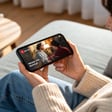In recent years, a notable trend has emerged where individuals over 50 are swapping their smartphones for the nostalgic charm of flip phones. This shift highlights more than just a quest for simplicity; it represents a broader movement towards a minimalist lifestyle, digital detox, and even social connection.
The Nostalgia Factor
For many, flip phones evoke memories of a time when technology wasn't so pervasive. The tactile experience of opening and closing a flip phone is different from the swipe-and-tap interface of modern smartphones. It's almost comforting.
Many people in the over-50 demographic grew up in an era where communication was straightforward. They had less dependence on social media and the constant barrage of notifications. By reverting to flip phones, they’re finding solace in a simpler form of communication. This nostalgic appeal not only offers a break from the chaos but also provides a sense of control over their social interactions.
Simplicity and Focus
Modern smartphones, while incredibly advanced, can also be overwhelming. Many features remain unutilized, cluttering their user experience. Over-50s are seeking devices with fewer distractions. A flip phone allows calls and texts without the daily parade of alerts from apps.
That said, these devices aren't completely devoid of modern utilities. Some newer flip models include Bluetooth connectivity, cameras, and even internet access, blurring the line between nostalgia and convenience.
Digital Detox and Well-Being
The move towards flip phones is also rooted in a desire for a digital detox. Numerous studies indicate that excessive smartphone use can contribute to stress, anxiety, and even feelings of isolation. By trading in a smartphone for a flip phone, users can reclaim their time and focus on face-to-face interactions.
This trend isn’t limited to those over 50, either. Some younger individuals, including Gen Z, are also finding solace in flip phones as they seek to reduce their tech dependency. Flip phones are seen as tools that promote healthier life balances by reducing time spent online.
Cost-Effectiveness
Let's face it—smartphones can be expensive. A flip phone offers a budget-friendly alternative without sacrificing necessary features. Depending on the model, you could spend anywhere from $20 to about $50, making it a sensible choice for individuals looking to cut costs. In this economy, that matters.
Many companies specialize in crafting modern flip phones that include key features without the hefty price tag associated with high-end smartphones. This financial aspect resonates particularly well with seniors who often operate on fixed incomes.
Is the Flip Phone Right for You?
If you’re considering switching from a smartphone to a flip phone, there are several factors to think about:
- User Needs: Identify what you truly need in a device. Are you primarily texting or making calls?
- Lifestyle Choices: Analyze how often you use social media. Can you live without constant access to apps?
- Comfort with Technology: Consider how much you're willing to embrace the limitations of a flip phone. If you're tech-savvy but overwhelmed by modern smartphones, a flip phone might be a perfect compromise.
Flipping the Script: A Shift in Perception
While many see flip phones as relics of the past, the shift towards them among the over-50 demographic—and even younger users—marks a change in perception. It highlights a preference for communication that's more personal and less cluttered. The wisdom in prioritizing face-to-face interaction and self-care reflects a growing awareness of how technology impacts our lives.
Common Questions
Why are flip phones making a comeback among seniors?
Flip phones are appealing because they balance functionality with simplicity. They reduce distractions and provide a more manageable user experience without sacrificing essential communication.
Are modern flip phones better than old ones?
Yes! Today's flip phones often feature upgraded technology, including better cameras and connectivity options like Bluetooth. They blend the best of both worlds: retro design and modern features.
Conclusion
The trend of trading in touchscreens for flip phones among the over-50s encapsulates a desire to reconnect with simpler, more authentic forms of communication. By opting for these devices, seniors can embrace a lifestyle that promotes mental well-being, financial savvy, and more meaningful interactions. Whether nostalgia drives them or they simply seek a break from the overwhelm, the adoption of flip phones is a testament to the enduring allure of simplicity in a complex world.
For more insights on choosing the right mobile solution, consider checking sources like Lively's guide on flip phones vs. smartphones. Find out what suits your lifestyle best!
Disclaimer: This content is for informational purposes only and should not replace professional advice.
Tags

About Graham Elwood the Author
Graham Elwood is a seasoned finance journalist with a keen eye for uncovering the most inspirational success stories in the financial sector, particularly those involving groundbreaking startups and visionary entrepreneurs.
Recommended Articles
5 Short Drama Apps That Will Keep You Hooked With Just One Episode
Discover 5 engaging short drama apps that keep you hooked from the first episode, offering quick entertainment at your fingertips.
5 Workout Apps That Will Transform Your Routine—No Gym Required
Discover 5 transformative workout apps that elevate your fitness routine without needing a gym. Stay fit anywhere, any time!
2026 Ford F-150: Tougher and Smarter Than Ever
Discover the 2026 Ford F-150, featuring enhanced performance, smart technology, and a focus on safety. The toughest truck is smarter than ever!
2026 Hyundai H350: The Work Van Reinvented
Discover the innovative features of the 2026 Hyundai H350 work van, designed for businesses seeking efficiency, durability, and comfort.
Here’s What Changes When Medicare Lowers Prices for Key Medications
Discover how upcoming Medicare changes in 2026 will lower drug prices, enhance access, and improve coverage for seniors. Stay informed for better health.




